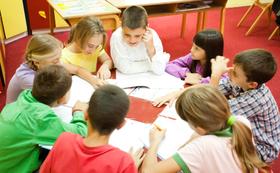Plymouth Educational Center was a public K-8 charter school, located in the Vivian H. Ross Campus at 1460 E Forest Ave in Detroit, Michigan 48207. It was formerly K-12.
Serving 399 students in grades Kindergarten-8, Plymouth Educational Center ranks in the bottom 50% of all schools in Michigan for overall test scores (math proficiency is bottom 50%, and reading proficiency is bottom 50%).
The percentage of students achieving proficiency in math was ≤1% (which was lower than the Michigan state average of 35%). The percentage of students achieving proficiency in reading/language arts was 6% (which was lower than the Michigan state average of 45%).
The student-teacher ratio of 29:1 was higher than the Michigan state level of 17:1.
Minority enrollment was 99% of the student body (majority Black), which was higher than the Michigan state average of 37% (majority Black).
Top Rankings
Plymouth Educational Center ranks among the top 20% of public schools in Michigan for:
Category
Attribute
Percent Eligible For Free Lunch
School Overview
School Type
Grades Offered
Grades Kindergarten-8
(No virtual instruction)
(No virtual instruction)
Total Students
399 students
Gender %
Total Classroom Teachers
14 teachers
Year Founded
1995
School Rankings
Overall Testing Rank
#3024 out of 3025 schools
(Bottom 50%)
(Bottom 50%)
Math Test Scores (% Proficient)
≤1%
35%
Reading/Language Arts Test Scores (% Proficient)
6%
45%
Science Test Scores (% Proficient)
≤5%
38%
Student-Teacher Ratio
29:1
17:1
American Indian
n/a
1%
Asian
n/a
4%
Hispanic
n/a
9%
Black
98%
18%
White
1%
63%
Hawaiian
1%
n/a
Two or more races
n/a
5%
All Ethnic Groups
Participates in the National School Lunch Program (NSLP)
Yes
Eligible for Free Lunch
92%
50%
Eligible for Reduced Lunch
1%
4%
School Statewide Testing
School District Name
Plymouth Educational Center Charter School District
Source: National Center for Education Statistics (NCES), MI Dept. of Education
Profile last updated: 02/09/2025
Frequently Asked Questions
What is Plymouth Educational Center's ranking?
Plymouth Educational Center is ranked #3024 out of 3,025 schools, which ranks it among the bottom 50% of public schools in Michigan.
What percent of students have achieved state testing proficiency in math and reading?
≤1% of students have achieved math proficiency (compared to the 35% MI state average), while 6% of students have achieved reading proficiency (compared to the 45% MI state average).
How many students attend Plymouth Educational Center?
399 students attend Plymouth Educational Center.
What is the racial composition of the student body?
98% of Plymouth Educational Center students are Black, 1% of students are White, and 1% of students are Hawaiian.
What is the student-teacher ratio of Plymouth Educational Center?
Plymouth Educational Center has a student ration of 29:1, which is higher than the Michigan state average of 17:1.
What grades does Plymouth Educational Center offer ?
Plymouth Educational Center offers enrollment in grades Kindergarten-8 (No virtual instruction).
What school district is Plymouth Educational Center part of?
Plymouth Educational Center is part of Plymouth Educational Center Charter School District.
In what neighborhood is Plymouth Educational Center located?
Plymouth Educational Center is located in the Forest Park neighborhood of Detroit, MI.
Recent Articles

Public School Open House & Enrollment Season Guide
A parent-focused guide to the public school open house and enrollment season, with expert questions, timelines, and decision tips.

School Supply Budget 2026: Fees, Books, Tech Costs
School Supply Budget 2026 guide for parents, covering fees, textbooks, technology, and hidden extras to plan ahead.

Education Funding in America (2025 Update)
Comprehensive 2025 update on public school funding in America, new federal and state policies, per-pupil spending, and equity challenges.





